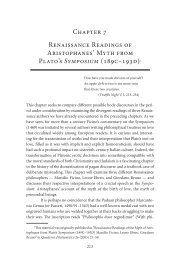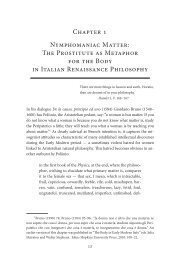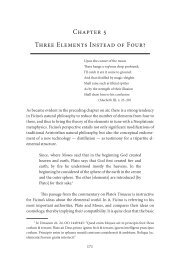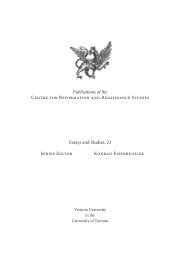Chapter 2 Matter as a Mirror: Marsilio Ficino and Renaissance ...
Chapter 2 Matter as a Mirror: Marsilio Ficino and Renaissance ...
Chapter 2 Matter as a Mirror: Marsilio Ficino and Renaissance ...
You also want an ePaper? Increase the reach of your titles
YUMPU automatically turns print PDFs into web optimized ePapers that Google loves.
<strong>Matter</strong> <strong>as</strong> a <strong>Mirror</strong> 63<br />
duty, the soul moves downward from the celestial spheres to the centre of<br />
the universe. Here it may be arrested against its will by the physical attractions<br />
of the body. In order to explain how souls <strong>and</strong> bodies may communicate,<br />
<strong>Ficino</strong> introduces the concept of spiritus. This term w<strong>as</strong> widely used in<br />
contemporary medical discourses to account for what we would call today<br />
psycho-physical phenomena. Spiritus is an intermediary substance, a kind<br />
of pure <strong>and</strong> clean envelope or robe (purum tegumentum). This fabric is less<br />
bright <strong>and</strong> clear than the soul, but more transparent than the body. 55 According<br />
to <strong>Ficino</strong>, the soul h<strong>as</strong> the capacity to imprint the forms (it receives<br />
from mens) “without difficulty” into this ethereal body. Once activated by<br />
soul, the spiritus turns into a fine vapour originating from the thinnest<br />
blood <strong>and</strong> corporeal heat. The spiritus spreads from the heart to all parts<br />
of the body. In this c<strong>as</strong>e, spiritus functions like a mirror that communicates<br />
the powers of the soul to the body, transforming “a lifeless substance into<br />
the form of our lives.” The spiritus thus h<strong>as</strong> a vital function in explaining the<br />
embodiment of souls. 56 (See also chapter five.)<br />
In the Neoplatonic tradition, this embodiment of the soul is described<br />
in terms of reflection in a mirror. In most instances, <strong>Ficino</strong> describes<br />
the descent of soul into the corporeal world <strong>as</strong> a dis<strong>as</strong>trous event<br />
that imprisons a spiritual being into a body <strong>and</strong> thus diverts soul from its<br />
55 The paradoxical quality of spiritus is well expressed in the De vita III, 3: 257, it is<br />
“qu<strong>as</strong>i non corpus et qu<strong>as</strong>i iam anima” <strong>and</strong> “excelentior corpus, qu<strong>as</strong>i non corpus” (253).<br />
56 De amore VI 9: 225 <strong>and</strong> V 6: 205; De vita III, 22: 368: “intellige tum corporum<br />
coelestium dotes in corpora nostra venire per spiritum nostrum rite paratum […].” Then<br />
at III, 1: 247: “redigitur per spiritum nostrum ad vitae nostrae formam.” In other places,<br />
<strong>Ficino</strong> identifies this vehicle of the soul with complexion, which he calls the fifth constituent<br />
of a body: the ingredient of a body which is extremely susceptible to the messages <strong>and</strong><br />
comm<strong>and</strong>ments of the stars; complexio is the preparation or right disposition of the inanimate<br />
body for the reception of soul which is transmitted by celestial music, to which the<br />
body answers like resonant guitars do. See also De lumine chapt. 9, OO 979–980; Matton<br />
(1993) 143, with references: “À l âme du monde correspond donc un esprit du monde, au<br />
moyen du quel elle communique partout la vie au corps du monde. Comme le voulait Porphyre,<br />
cet esprit du monde est directement produit par l’âme du monde sous forme d’un<br />
halo lumineux, qui, explique Ficin, est formée de la lumière incorporelle et du diaphane,<br />
son véhicule. L’esprit du monde précède ainsi les quatre éléments, que l’âme du monde<br />
produit à partir de lui; c’est pourquoi il constitue bien une quinte essence.” On the topic in<br />
general, see Walker (1958) p<strong>as</strong>sim.







